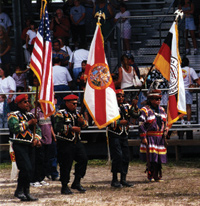|
||
      |
Tribal jackpot
To many people, an American Indian with a college degree, a Hummer, and a healthy bank account just doesn’t seem authentic, says assistant professor of anthropology Jessica Cattelino. “A rich Indian is an oxymoron in American popular culture. Indians are expected to be the untouched, the purely cultural, the poor, the traditional.” As proof, she cites a 1999 congressionally commissioned study on gambling. Conducted two decades after Florida Seminoles opened the country’s first high-stakes tribal casino and a few years after hundred-million-dollar profits started rolling in, the study determined that “most people opposed to Indian gaming were concerned that it would lead to cultural loss,” she says. In other words, explains Cattelino—who has worked with Seminoles since 1999 and whose book High Stakes: Florida Seminole Gaming, Sovereignty, and the Social Meanings of Casino Wealth (Duke University Press) is due out next year—people feared casinos would cost Indians their distinctiveness. “In popular conceptions, culture is very much a thing. It’s almost like there’s a cup of culture. It never seems to be gained—only lost—and if it is gained, that’s suspicious.” Instead, Cattelino sees culture as the activities, conversations, institutions, and customs that hold people together and reinforce collective identity.

A color guard of U.S. veterans (from left) Paul Bowers, Timmy Johns,
and Mitchell and Billy Cypress at a 2001 tribal powwow.
An outgrowth of her doctoral thesis—Cattelino earned a 2004 PhD from New York University—the book began with standard anthropological concerns: “politics and culture, the social meanings of money, what value is, how we think about political belonging.” Those questions play out vividly in Indian casinos, she says, where sovereign tribes reap tax-free profits and newfound money allows Indians to exercise their culture in new ways. South Florida, where Seminoles opened the first high-stakes Indian bingo hall in 1979 (and where revenues outpace those of more remote Indian casinos out West), “seemed like a good place to go.”
Florida Seminoles, she says, turn conventional wisdom about money’s corrosive influence on its head. Since opening Hollywood Bingo on an urban reservation just off Interstate 95, the 3,000-member, six-reservation tribe has experienced a “cultural renaissance,” Cattelino says. Its annual budget has swelled from less than $2 million before 1979, when federal grants provided nearly all funding, to about $600 million. Casino revenues now account for 95 percent of that budget, and tribal officials have used the money to launch cultural-education programs, courses in the Mikasuki and Muskogee languages, craft and artwork subsidies, fairs and festivals, and the Ah-Tah-Thi-Ki—meaning “to learn”—tribal history museum, whose curators scour auctions, dealer showrooms, and eBay for artifacts. “And now we’re starting to see the emergence of a high-end art market within Seminole reservations,” she says, “where master basketmakers and master patchwork-clothing makers sell their works within the tribe.” Seminole collectors commission paintings and jewelry. They have clothing sewn for each spring’s Green Corn Dance, a major gathering and rite of renewal.
Culture also informs seemingly nonethnic interactions, Cattelino says. “If you see a Seminole driving a Hummer or a customized Harley, you might say that isn’t very traditional. But if you find out their matrilineal relatives lent the money for it”—as they would, according to Seminole custom—“and that increased money has reanimated circuits of exchange based in the clan system, the situation starts to look a little different.”
Besides fueling a cultural resurgence, casino money affords Seminoles greater self-determination (although at a price, Cattelino says: wealth has increased outside scrutiny, revealed intratribal tensions, and raised hard questions about spending and governance). The tribal government has taken over social services once left to the U.S. Bureau of Indian Affairs, providing health clinics; universal health insurance; programs for diabetes and for alcohol and drug rehab; and elder care. “You can go to school for life on the tribe’s dime,” both on and off the reservation, Cattelino says. The tribe offers after-school activities, day care, and GED programs. Entrepreneurs can get small-business loans. Seminole officials also fund housing and have begun reversing policies that subverted matrilineal-clan living in favor of the nuclear family. In the 1950s federal officials populated reservations with single-family homes, prohibiting open-sided, palmetto-thatched chickees that Seminoles had long organized into circular camps where matrilineal relatives slept, worked, and ate together. Fifteen years after the tribe reclaimed reservation housing, nearly every home now has a backyard chickee, and officials are considering developments to evoke clan-camp structure.
Perhaps most dramatically, thanks to casino profits, all Seminoles—even minors—receive monthly dividend checks from the tribal government, a fact that has transformed household economies. “Whereas most Seminoles were living in grinding poverty prior to casinos, now very few are.” Money offers them freedom to be themselves. “If you have to work three jobs and don’t have time to be around your kids; or don’t have health care, so people get sick and die—it’s harder to be who you want to be, as a person and as a people.”
Awash in all this fortune and indepence, Seminoles navigate an increasingly complex terrain of overlapping indigenous and American citizenship. “It would be tempting to simply say there’s a conflict there,” Cattelino says. Indeed, for more than 100 years, federal policy assumed there was. “But this is not a zero-sum game between tribalism and American citizenship.” Although high voter turnout in spring tribal elections can dampen participation in November U.S. elections, Seminole veterans of the American military, for instance, enjoy honored status—and often political power—on the reservation. “We have to see tribal sovereignty in relation to settler-state sovereignty,” she says. “We can’t take citizenship as something that each person has in exactly the same way. Indians force us to ask what it means to have overlapping citizenship and interdependent forms of sovereignty.”